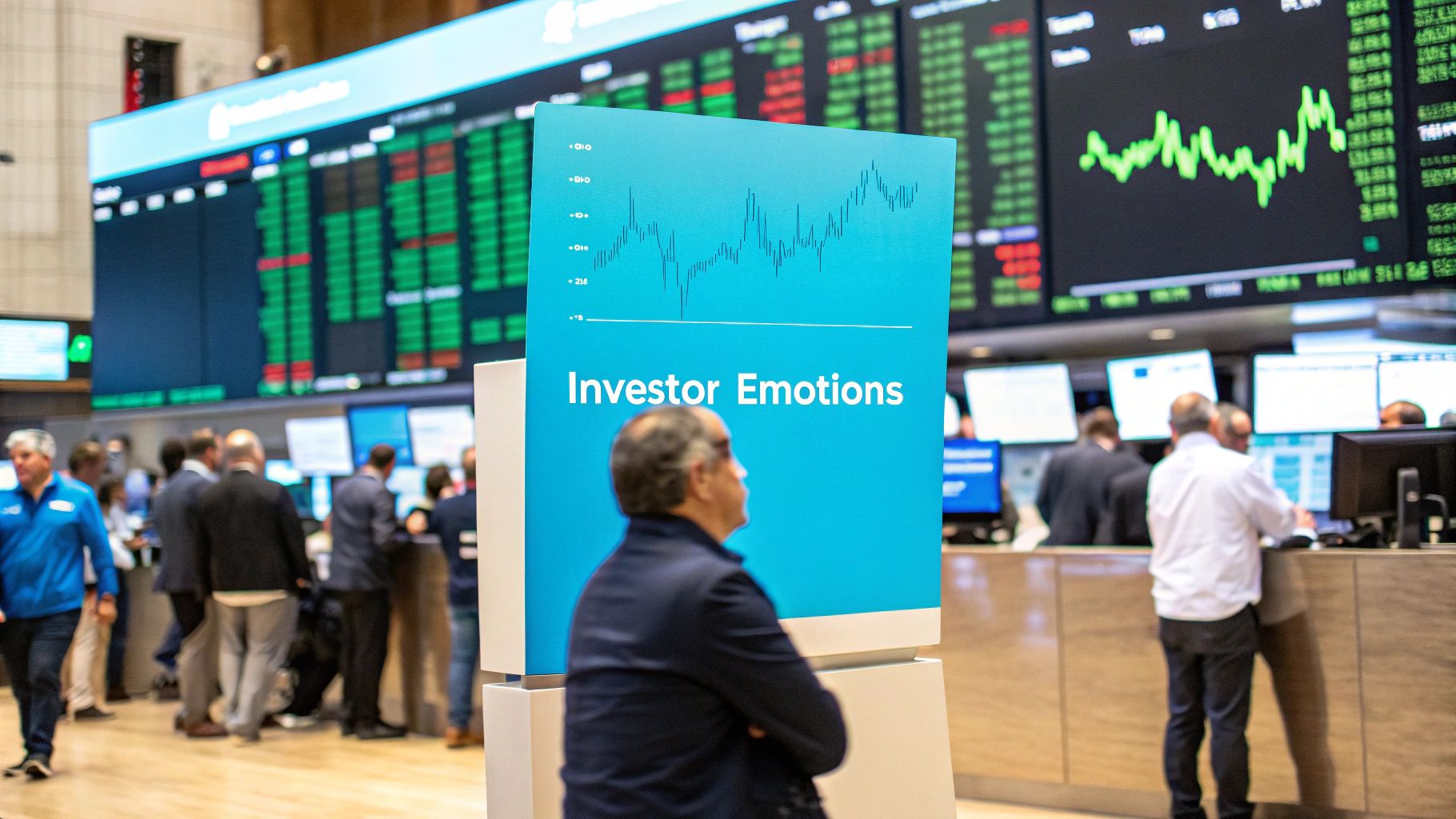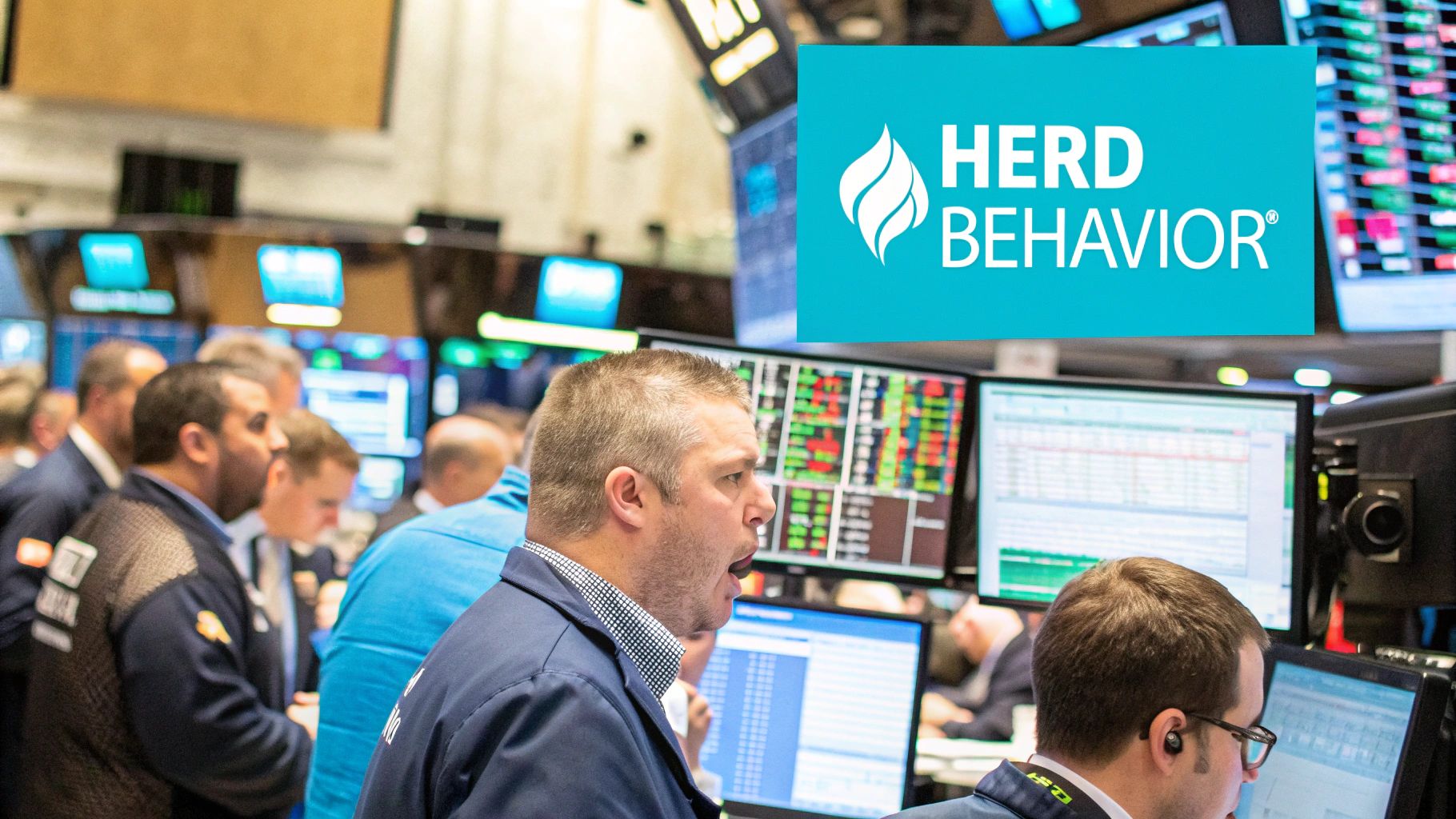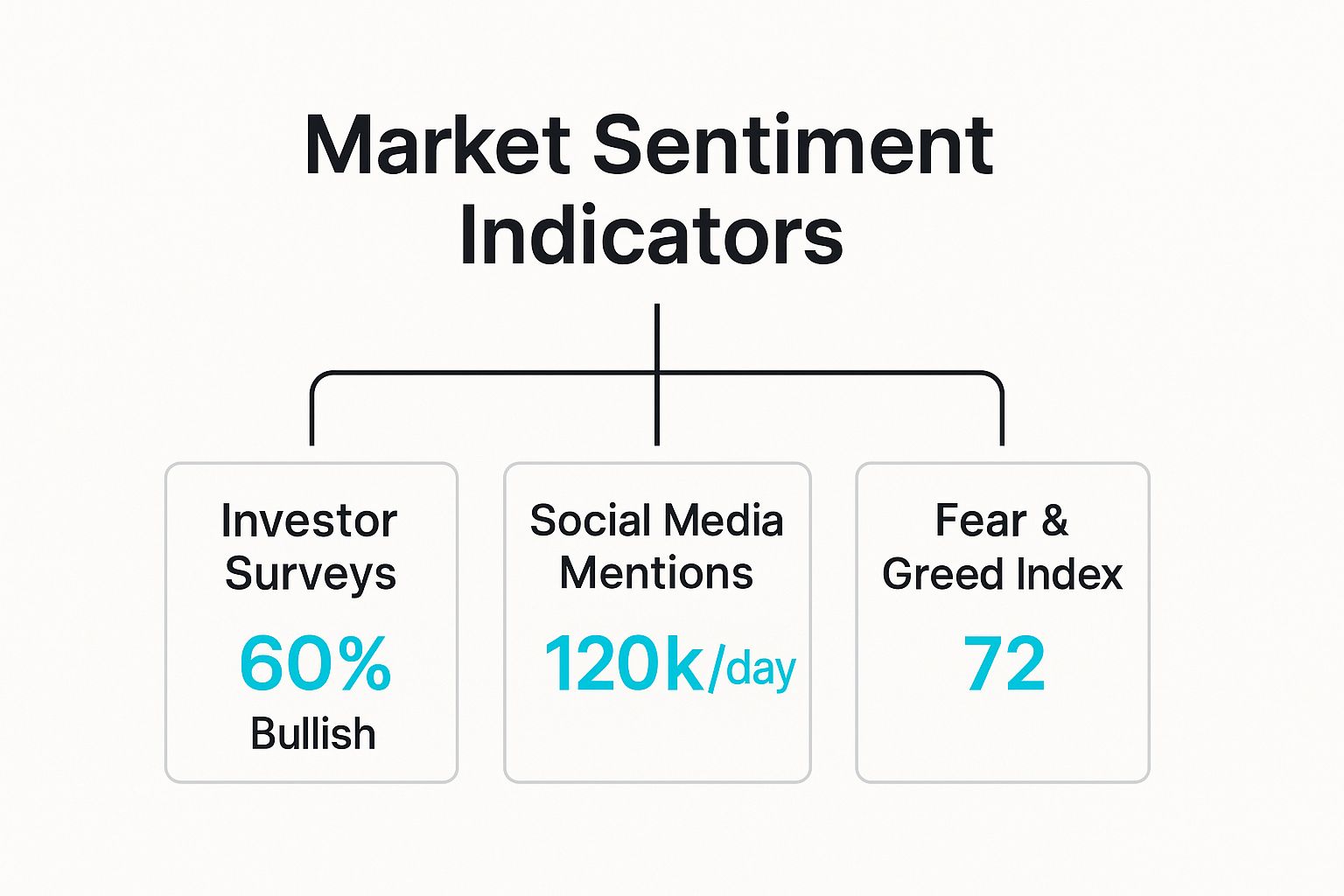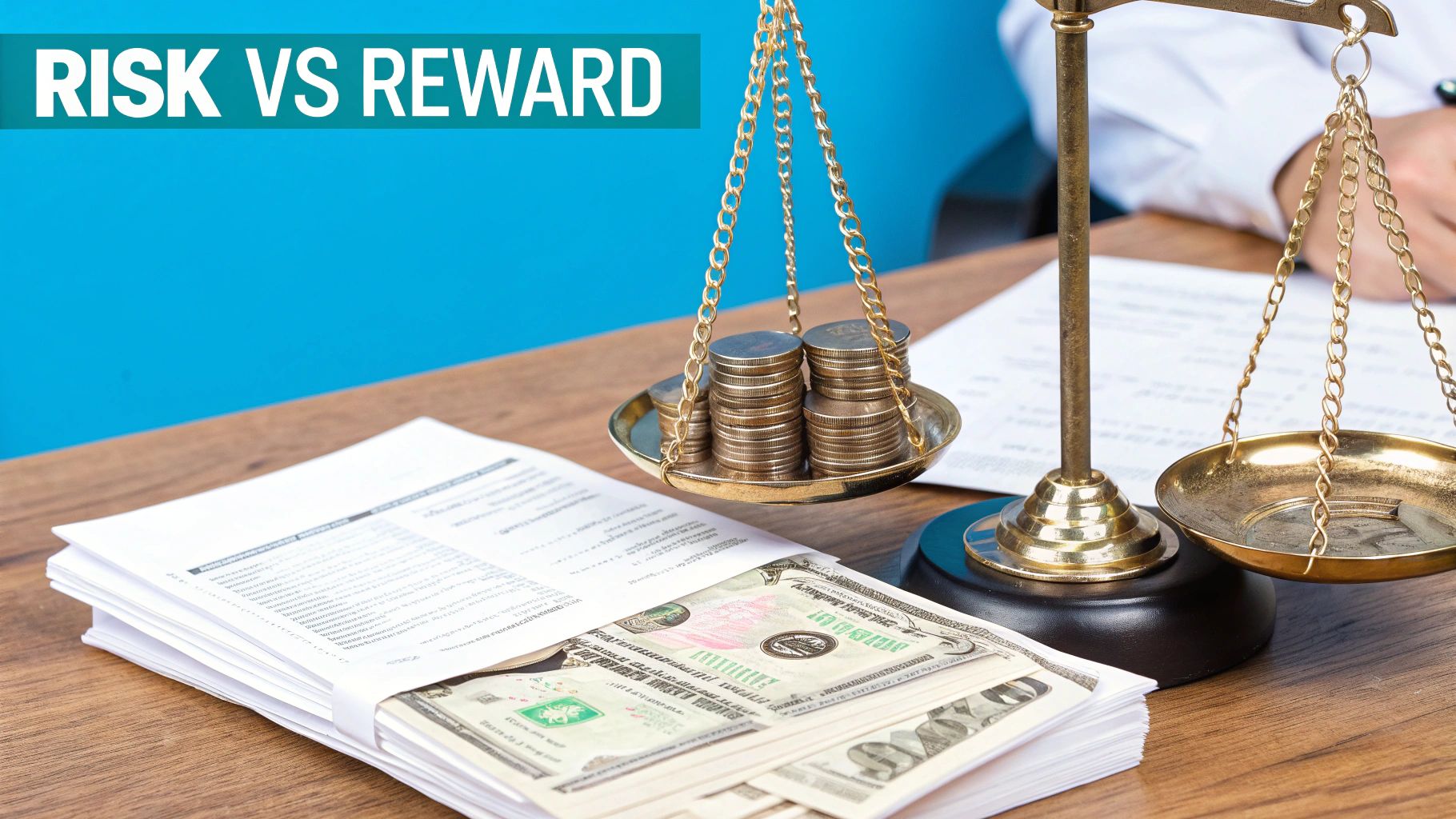




Ever wonder what really moves the markets? It's not just about numbers on a spreadsheet or company earnings reports. The truth is, the market is driven by people, and people are driven by emotion. That's the core idea behind market psychology: studying how our collective feelings, mental shortcuts, and social pressures shape the financial world.
At its heart, the market is a battleground between two powerful forces: fear and greed. These emotions are what create the dramatic swings and predictable-in-hindsight trends that pure, cold logic can't explain.

Think of the stock market less like a supercomputer and more like a massive, emotionally volatile crowd. This is the essence of market psychology. It’s the recognition that financial markets are fueled by the collective hopes, fears, and instincts of millions of individual investors. Prices don't just reflect hard data; they are a mirror of human sentiment, swinging between periods of irrational exuberance and paralyzing pessimism.
This emotional tide is powerful enough to create huge market moves, often with very little change in the actual fundamentals of the companies involved. That’s why understanding this human element is every bit as critical as analyzing a balance sheet. It helps us make sense of why a perfectly solid company's stock can suddenly tank, or why speculative bubbles form around assets with little to no real value.
Old-school economic theories love to paint a picture of the "rational investor"—someone who always makes logical choices to maximize their profit. But anyone who has spent time in the markets knows that’s rarely how it works. This is where behavioral finance comes in, showing us that human decision-making is often messy, emotional, and full of predictable errors.
These psychological undercurrents are the real force behind some of the market's most spectacular booms and busts. It all boils down to a few key factors:
In financial markets, logic might be the steering wheel, but emotion is the gas pedal. Market psychology studies what happens when investors stomp on the gas—or slam on the brakes—without ever looking at the map.
Today, information—and misinformation—spreads like wildfire. The impact of collective emotion is stronger and faster than ever before. A single tweet from an influential figure or a sensational news headline can set off a global wave of panic selling or euphoric buying in a matter of minutes.
For any trader, ignoring the market's psychological state is like a sailor ignoring the weather forecast. You can be the most skilled captain in the world, but you're still at risk of getting caught in a storm you never saw coming.
By digging into the principles of market psychology, we can start to see these emotional patterns as they form. This gives us a massive edge. It helps us anticipate market overreactions, keep our own emotions in check, and ultimately, make more disciplined and strategic decisions. It’s about shifting from just reacting to price movements to understanding the human behavior that’s causing them in the first place.

If you want to understand market psychology, you have to look back in time. The patterns of hope, greed, and panic we see today aren't new—they're just echoes of the same human biases that have been driving markets for centuries. History gives us the best case studies, proving that no matter how much technology changes, the raw emotions of greed and fear are still the most powerful forces in finance.
Think of these historical bubbles as a mirror. They reflect the same collective euphoria and mass panic that fuel modern market cycles. They show us, time and again, that when groupthink kicks in, common sense and fundamental value are usually the first things to go out the window. Learning from these cautionary tales helps us spot the early warning signs of irrationality in today's markets.
One of the most spectacular examples is the Dutch Tulip Mania of the 1630s. It all started with a simple appreciation for a beautiful flower, but it quickly spiraled into a full-blown speculative disaster. At its absolute peak, a single rare tulip bulb was worth more than a grand estate.
This wasn't about gardening. It was a textbook case of herd behavior. People were buying bulbs not because they wanted to plant them, but because they were convinced someone else would pay even more tomorrow. The fear of missing out (FOMO) was so strong it pushed the price of tulips into the stratosphere, completely disconnected from reality. When the bubble finally popped, prices crashed almost overnight, ruining countless investors. You can dive deeper into how these recurring psychological dynamics shape financial outcomes on verifiedinvesting.com.
The Tulip Mania is a powerful reminder that any asset, no matter how mundane, can become the subject of a speculative bubble when collective emotion overrides rational thought. The asset itself is irrelevant; the human psychology is the constant.
The script from the Tulip Mania has been replayed throughout history, just with different actors and assets. But if you look closely, you’ll see the same human tendencies at play.
When you line these events up, separated by hundreds of years, the pattern is unmistakable. The assets change—tulips, trading rights, internet stocks—but the human psychology driving the madness stays the same.
The core drivers are timeless:
These historical meltdowns aren't just fascinating stories; they are essential lessons in the psychology of markets. They prove that at their core, market cycles are simply human emotional cycles. Getting a handle on that fact is the first step toward navigating the waves of optimism and pessimism that will always define the financial world.
Our brains are hardwired for efficiency. To get through the day, we rely on mental shortcuts—what psychologists call cognitive biases—to make snap judgments. These shortcuts serve us well in most situations, but they can be a recipe for disaster in the financial markets.
The very instincts that keep us safe in the real world can trick us into selling at the bottom or buying at the very top. Understanding these built-in mental glitches is the first step toward not letting them run your portfolio. Market psychology is really just the study of these biases playing out on a massive scale, creating patterns that disciplined traders can learn to spot.
We all have a natural urge to be right. This leads to confirmation bias, where we actively hunt for information that proves our existing beliefs and ignore anything that challenges them. It's like creating a personalized echo chamber for our investment thesis.
Let's say you're excited about a particular stock. You'll likely find yourself reading every glowing analyst report and positive news story you can find. At the same time, you might gloss over that one little article mentioning weak financials or a new competitor. This creates a dangerous blind spot, convincing you to hold a losing position for far too long.
Humans are social animals. We look to the crowd for cues, and this instinct spills directly into the market through herding behavior. It’s that powerful fear of missing out (FOMO) that kicks in when everyone seems to be making money on something, or the panic that sets in when everyone is selling.
This is what inflates bubbles and makes crashes so much worse. When a stock is rocketing up, the temptation to jump on the bandwagon is intense. When the market turns and fear takes over, the pressure to sell with everyone else is overwhelming. Herding causes us to abandon our own homework and simply follow the masses—a classic strategy for buying high and selling low.
Market sentiment indicators give us a window into this collective mood. They help us see if the herd is feeling greedy or fearful, giving us a vital piece of context before we act.
This infographic shows how we can measure the market's emotional state using tools like investor surveys and the popular Fear & Greed Index.

As you can see, a high Fear & Greed Index score of 72 paired with 60% bullish survey results paints a clear picture: greed is the dominant emotion right now.
Cognitive biases are subtle but powerful forces that can quietly sabotage even the most well-thought-out investment plan. The table below breaks down a few of the most common ones.
Recognizing these biases in our own thinking is half the battle. Once you can name them, you can start to counteract their influence on your decisions.
Ever noticed how losing $100 feels way worse than winning $100 feels good? That's loss aversion. Psychologically, the pain of a loss is roughly twice as powerful as the joy from an equal gain.
This has a huge impact on how we trade.
Loss aversion short-circuits rational thinking. It pushes us to let our losers run and cut our winners short—the exact opposite of what we should be doing. Learning to manage these emotions is critical, and we cover more strategies in our guide to essential trading psychology tips.
A little success can be a dangerous thing. After a string of good trades, it's easy to fall into the overconfidence trap and think you've got the market all figured out. This almost always leads to taking on way too much risk.
Overconfident traders tend to trade too often, which lets transaction fees eat away at their profits. They might also put too much of their portfolio into one or two "sure things." This bias makes us forget about luck and the simple fact that the market is unpredictable, setting us up for a rude awakening. Acknowledging these mental traps is the first step toward a more disciplined and clear-headed approach to investing.

If you strip away all the charts, algorithms, and complex financial instruments, what’s left? Two raw, powerful emotions that drive nearly everything: greed and fear. These feelings are the twin engines powering the market's endless boom-and-bust cycles. They act like a giant pendulum, swinging sentiment from one extreme to the next.
Think of it this way: Greed is the fuel for the rocket ship going up. It’s what creates those periods of “irrational exuberance” where prices feel like they can only go higher, completely detaching from any real-world value. On the flip side, fear is the force that cuts the engines and sends everything plummeting back to earth, sparking panicked sell-offs where logic gets tossed out the window.
To truly get a feel for this, we just need to look back at history. The markets are littered with dramatic examples that show just how powerful collective human emotion can be.
Remember the late 1990s? The internet was new, exciting, and poised to change everything. This created the perfect story—a "new economy" where the old rules of business and valuation simply didn't apply anymore. It was a narrative so compelling that it sparked a full-blown speculative frenzy.
Investors were terrified of being left behind. This "fear of missing out" (FOMO) led them to throw money at any company with a ".com" in its name, even if it had zero revenue or a viable business plan. The collective belief was that getting in early was a one-way ticket to riches. This is greed in its purest form, completely eclipsing rational analysis.
When greed is the dominant emotion in the market, the story becomes far more important than the balance sheet. Investors stop asking, "Is this a valuable company?" and start asking, "Will someone else pay me more for this tomorrow?"
The Nasdaq Composite Index nearly tripled between 1997 and March 2000, driven by nothing more than pure, unadulterated optimism. This created a dangerous feedback loop: rising prices pulled in more buyers, which pushed prices even higher. Eventually, of course, the bubble popped. Once people realized many of these companies would never turn a profit, greed flipped to fear almost overnight, and the crash was every bit as dramatic as the climb.
If the dot-com bubble was a case study in greed, the 2008 financial crisis was a masterclass in fear. What started as a problem in the U.S. housing market quickly spiraled into a global contagion, thanks to a web of complex and poorly understood financial products.
When a giant like Lehman Brothers went under, sheer panic gripped the markets. The goal was no longer about making money; it was about not losing everything. This triggered a primal herd instinct, but instead of chasing gains, the herd was stampeding for the exits.
Investors started selling everything—good assets, bad assets, it didn't matter. The only thing that felt safe was cash. This fire sale created a domino effect where falling prices led to more selling, which pushed prices down even further. The S&P 500 lost over 50% of its value from its 2007 peak to the low in March 2009.
This crisis put a spotlight on the destructive nature of market fear:
The dot-com bubble and the 2008 crisis are perfect bookends, showing the two extremes of market psychology. Greed and fear aren't separate forces; they are two sides of the same coin, locked in a perpetual cycle where one inevitably gives way to the other. To go even deeper into this dynamic, you can read our complete guide on the psychology of a market cycle.
By learning to spot the tell-tale signs of widespread greed (like parabolic charts and cocktail party stock tips) or widespread fear (like extreme volatility and news headlines about "capitulation"), you can position yourself to act logically. It's about keeping a level head when everyone else is losing theirs, turning those emotional extremes from a threat into a strategic opportunity.
For decades, traditional economics clung to a neat, tidy idea: the Efficient Market Hypothesis (EMH). It paints a picture of a market where all known information is instantly reflected in an asset's price. In this world, every investor is a perfectly rational actor, and prices only move when truly new, unpredictable information comes to light.
If the market really worked this way, trying to find an edge would be a fool's errand. It’d be a pure game of chance. But we all know it’s not that simple. Just a quick glance at any stock chart reveals a world that’s often chaotic, emotional, and anything but perfectly rational.
The truth is, the fingerprints of human psychology are all over the financial markets, creating patterns that pure logic can’t explain.
The idea of a rational market is a clean academic concept, but it shatters when it meets the real world. Financial data is full of quirks and anomalies that just don't fit the EMH mold. In fact, a deep dive into the numbers shows recurring, statistically significant patterns that defy "rational" market behavior. You can explore the detailed statistical research for yourself.
These repeating statistical patterns are the measurable footprints of our collective emotions. They show how psychological forces, like the instinct to follow the herd or overreact to news, create predictable behaviors that show up time and time again, across different markets and different decades.
Two of the biggest pieces of evidence against a perfectly logical market are:
The Efficient Market Hypothesis works if you assume investors are emotionless robots, perfectly calculating every move. The reality is that markets are driven by people—people prone to fear, greed, and hope. These forces don't just exist; they leave a clear, measurable impact on prices.
So, what’s behind all these market oddities? The answer is us. It’s the very human biases we all carry. The EMH model has no place for things like loss aversion, the fear of missing out, or runaway overconfidence. It can't explain the trader who panic-sells at the bottom or the investor who piles into a meme stock just because it’s trending.
These behaviors aren't just random "noise" in the system—they are the system. They are fundamental drivers of market movement. The irrationality of the crowd creates both the biggest risks and the greatest opportunities.
The myth of the perfectly rational market is a useful starting point, but acknowledging its limitations is the first real step toward understanding the true psychology of markets. It proves that human emotion isn't a footnote—it's a powerful and predictable force shaping financial reality.
It's one thing to know that emotions drive the market, but it’s another thing entirely to measure them. How do you actually tell if the "crowd" is getting dangerously greedy or is frozen by fear? Pros use specific sentiment indicators that act like a thermometer for the market’s emotional state, giving them a serious edge.
These tools aren't a crystal ball, of course. They don't predict the future. What they do is provide critical context, helping you figure out if the price action you're seeing is based on sound logic or just raw emotion. Learning to read these signals gives you a much clearer picture of what’s really going on beneath the surface.
You’ve probably heard of the VIX. It’s often called the "fear index," and for good reason—it’s one of the most-watched sentiment gauges out there. The VIX doesn't track stock prices. Instead, it measures the market's expectation of how choppy things will be over the next 30 days, all based on options trading in the S&P 500.
Here’s a simple way to think about it:
I like to think of the VIX as the market's pulse. A slow, steady beat is business as usual. A frantic, spiking pulse means panic has set in.
There's an old trading saying that goes, "When the VIX is high, it's time to buy." It perfectly captures that contrarian mindset. Extreme fear often leads to oversold conditions, creating opportunities for those who can stay level-headed when everyone else is losing theirs.
Another fantastic tool is the Put/Call Ratio. This one is pretty straightforward: it compares the trading volume of bearish "put" options to bullish "call" options. A put option is basically a bet that an asset's price will go down, while a call option is a bet it will go up.
This ratio tells you what traders are actually doing with their money, not just what they're saying.
By keeping an eye on indicators like these, you can stop just reacting to price charts and start understanding the emotional currents moving them. It’s a huge step toward truly mastering the psychology of the markets.
Diving into market psychology can feel a bit like learning a new language. It’s natural to have questions as you start to connect the dots. Let's tackle some of the most common ones that traders and investors ask.
That’s the million-dollar question, isn't it? The short answer is no, not with perfect certainty. Market psychology isn’t a crystal ball.
Think of it more like reading the weather. A forecast might call for an 80% chance of rain, but it doesn't guarantee a downpour at exactly 2:00 PM. It just gives you the odds so you can decide whether to bring an umbrella.
Similarly, understanding the market's mood helps you gauge probabilities. When you see extreme greed taking over, you know the odds of a reversal are getting higher. It’s all about making smarter, more informed bets based on how the crowd is likely to behave.
It's easy to think this is just a game for day traders, but that's a huge misconception. For long-term investors, understanding market psychology is your best defense against your own worst instincts.
Its biggest benefit is emotional discipline. When you can spot a market-wide panic for what it is—mass fear, not necessarily a sign that your favorite company is doomed—you can avoid the classic mistake of selling everything at the bottom.
A deep understanding of market psychology turns long-term investors into smart contrarians. When everyone else is dumping good stocks out of fear, you see a potential buying opportunity.
Instead of getting carried away by the emotional current, you can use those moments of irrational panic to strengthen your portfolio for the years ahead.
You’d think so, right? If you replace emotional humans with cold, calculating machines, the market should become perfectly logical. But it’s not that simple.
The catch is that humans design these algorithms. And, often, our own biases get coded right into their instructions. An algorithm designed to sell automatically after a certain percentage drop doesn't think—it just executes. This can turn a small dip into a full-blown flash crash, essentially putting herd behavior on hyperdrive.
These systems react at speeds we can't even comprehend, which can sometimes make the market more volatile, not less. So instead of erasing emotion, AI and algorithms often just end up amplifying the same human behaviors we've seen for centuries, only much, much faster.
Ready to trade with logic instead of emotion? EzAlgo provides AI-driven signals that help you identify high-probability setups and manage risk without the guesswork. See how our tools can bring discipline to your strategy at https://www.ezalgo.ai.